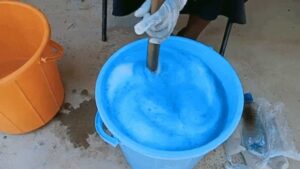Back to: Pre Vocational Studies Primary 4
Welcome to class!
In today’s class, we shall be talking about how to prepare liquid soap. I trust you will enjoy the class!
How to Prepare Liquid Soap: A Step-by-Step Guide
Liquid soap is a versatile product used for cleaning hands, dishes, and surfaces, can be easily made at home. The key ingredients include:

- Base: This is the primary cleaning agent, often a surfactant like Sodium Lauryl Sulfate (SLS) or Sodium Laureth Sulfate (SLES).
- Water: Used to dilute the base and other ingredients.
- Thickening Agent: Substances like salt or sugar can be added to increase the viscosity of the soap.
- Preservative: This prevents the growth of bacteria and mold.
- Fragrance: Essential oils or fragrance oils can be added to give the soap a pleasant scent.
- Color: Food coloring or natural colorants can be added to give the soap a desired color.
Steps to Make Liquid Soap

- Gather Your Ingredients:
- Ensure you have all the necessary ingredients, including the base, water, thickener, preservative, fragrance, and color.
- Make sure to use distilled water to avoid impurities that could affect the soap’s quality.
- Prepare the Base:
- In a clean container, measure the required amount of the base.
- Gradually add water to the base, stirring continuously to avoid lumps.
- Add Thickening Agent:
- Slowly add the thickening agent, such as salt or sugar, to the mixture. Stir continuously until the desired consistency is achieved.
- Incorporate Preservative:
- Add the preservative to the mixture and stir well to ensure it is evenly distributed.
- Add Fragrance and Color:
- Add your desired fragrance and color to the mixture. Stir until the color is evenly dispersed and the fragrance is well-blended.
- Transfer to Container:
- Pour the liquid soap into clean, sanitized containers.
Tips for Making High-Quality Liquid Soap

- Water Quality: Use distilled water to avoid mineral deposits that can affect the soap’s quality.9
- Temperature Control: Avoid extreme temperatures during the soap-making process.10
- Proper Storage: Store your liquid soap in a cool, dry place to prevent spoilage.
- Testing: Before mass production, test a small batch to ensure the desired consistency, fragrance, and cleaning properties.
- Safety First: Always wear gloves and protective eyewear when handling chemicals.
Additional Considerations for Different Types of Liquid Soap
- Hand Soap: Prioritize gentle surfactants and moisturizing ingredients to avoid drying out the skin.
- Dish Soap: Use a stronger surfactant to cut through grease and grime.11
- Body Wash: Consider adding natural oils and butters to moisturize the skin.
By following these steps and tips, you can create high-quality liquid soap that is both effective and gentle on your skin. Remember to experiment with different ingredients and fragrances to create your own unique formulations.
Welldone!
We have come to the end of today’s class. I hope you enjoyed the class!
In the next class, we shall be discussing Materials Tools for horticultural practices.
In case you require further assistance or have any questions, feel free to ask in the comment section below, and trust us to respond as soon as possible. See you in the next class!
